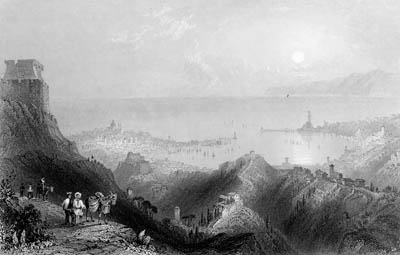![]()
This page is also available in French
![]()
Berlioz passed through Genoa twice in 1831, both times briefly. The first visit (ca 17-18 April) was en route from Florence when he had decided to return to Paris to take revenge on his fiancée Camille Moke who had betrayed him. The account he published later gave a light-hearted version of the event: in the Voyage en Italie of 1844 it was given the title Épisode bouffon (Burlesque episode). The account in the Memoirs (chapter 34), derived from it, removes the title but tells in humorous detail how Berlioz lost on the way the woman’s dress he planned to wear as a disguise in order to murder Camille and her mother (!), and so had to procure hurriedly a new outfit in Genoa. But it glosses over the fact that in Genoa Berlioz attempted to drown himself in the sea and had to be rescued, as emerges from a letter of 18 April addressed by Berlioz to Horace Vernet, the director of the Villa medici in Rome who needed to be reassured (CG no. 217, written from the village of Diano):
I am writing to you in great haste taking advantage of a momentary break. A hideous crime, a breach of trust of which I have been the victim, caused me to rave and rage all the way from Florence to here. I was flying to France to exact the most just and terrible revenge; at Genoa, a moment of dizziness and the most inconceivable weakness broke my will, I succumbed to the despair of a child; but then I got away with drinking salty water and being fished out like a salmon, then lying stretched out in the sun for fifteen minutes and throwing up violently for a whole hour. I don’t know who pulled me out, people believed I had accidentally fallen from the ramparts of the city. But I am alive, I must live for two sisters whose death would have followed mine, and live for my art.
Though I am still shaking like the hull of a ship firing its guns on all sides, I am giving you MY WORD OF HONOUR that I will not leave Italy; it is the only way to prevent me carrying out my plan. […]
The letters Berlioz wrote to his family in the following days gloss over the attempted suicide (CG nos. 219, 222).
Berlioz continued his journey to Nice, where he stayed a month.
On his way back to Rome, he passed through Genoa again (ca 23-25 May). He mentions in several letters the spectacular coastal road from Nice to Genoa high above the sea (CG nos. 230, 234), but only the Memoirs give an account of his experiences during his brief stay in Genoa (chapter 35):
While passing through Genoa I went to hear Paër’s Agnese. This opera enjoyed fame during the transition from night to dawn which preceded the rise of Rossini.
The feeling of cold boredom which overwhelmed me when I heard it was probably due to the dreadful performance which stifled the beauty of the work. The first thing that struck me was an example of the admirable habit that some people have: incapable of doing anything they believe they are entitled to redo or touch up everything. Their eagle eyes spot at once everything that is missing in a work. Hence the judicious and economical orchestration of Paër was reinforced with a bass drum, and the orchestral score, which had not been written to withstand it, disappeared completely, crushed by the stick of this accursed instrument.
Berlioz also remarks disapprovingly on the coldness with which the people of Genoa spoke of their illustrious compatriot Paganini, and on the absence of any monument in the city in honour of another famous Genoese, Christopher Columbus:
[...] While I was getting bored in his native city, Paganini was electrifying the whole of Paris. Cursing the misfortune which prevented me from hearing him, I tried at least to find out from his compatriots some information about him. But like the inhabitants of every merchant city, the Genoese are quite indifferent to the arts. They spoke to me coldly about the extraordinary man who has been greeted with acclamation in Germany, France and England. I enquired about his father’s house, but no one could point it out to me. I must admit that I also looked in Genoa for a temple, a pyramid, or any monument which I assumed would have been erected to the memory of Columbus. But never once in my wanderings through the streets of the ungrateful city where he was born and which he made famous, did I come across the bust of the great man who discovered the new world.
![]()
Genoa in the 1840s

This steel engraving from the 1840s by William Floyd is based on a drawing by William H Bartlett. The original copy of this engraving has been donated by us to the Hector Berlioz Museum and they hold the copyright for it.
© Michel Austin and Monir Tayeb for the picture and information on this page. All rights of reproduction reserved.
Copyright notice: The texts, photos, images and musical scores on all pages of this site are covered by UK Law and International Law. All rights of publication or reproduction of this material in any form, including Web page use, are reserved. Their use without our explicit permission is illegal.